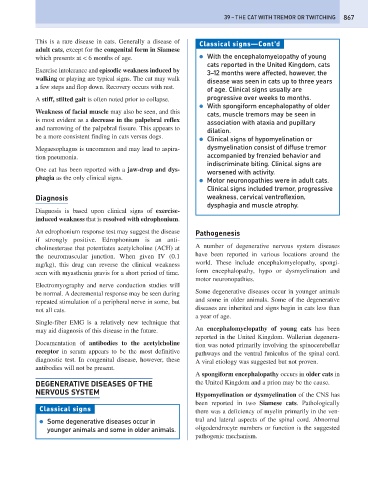Page 875 - Problem-Based Feline Medicine
P. 875
39 – THE CAT WITH TREMOR OR TWITCHING 867
This is a rare disease in cats. Generally a disease of
Classical signs—Cont’d
adult cats, except for the congenital form in Siamese
which presents at < 6 months of age. ● With the encephalomyelopathy of young
cats reported in the United Kingdom, cats
Exercise intolerance and episodic weakness induced by
3–12 months were affected, however, the
walking or playing are typical signs. The cat may walk
disease was seen in cats up to three years
a few steps and flop down. Recovery occurs with rest.
of age. Clinical signs usually are
A stiff, stilted gait is often noted prior to collapse. progressive over weeks to months.
● With spongiform encephalopathy of older
Weakness of facial muscle may also be seen, and this
cats, muscle tremors may be seen in
is most evident as a decrease in the palpebral reflex
association with ataxia and pupillary
and narrowing of the palpebral fissure. This appears to
dilation.
be a more consistent finding in cats versus dogs.
● Clinical signs of hypomyelination or
Megaesophagus is uncommon and may lead to aspira- dysmyelination consist of diffuse tremor
tion pneumonia. accompanied by frenzied behavior and
indiscriminate biting. Clinical signs are
One cat has been reported with a jaw-drop and dys-
worsened with activity.
phagia as the only clinical signs.
● Motor neuronopathies were in adult cats.
Clinical signs included tremor, progressive
Diagnosis weakness, cervical ventroflexion,
dysphagia and muscle atrophy.
Diagnosis is based upon clinical signs of exercise-
induced weakness that is resolved with edrophonium.
An edrophonium response test may suggest the disease Pathogenesis
if strongly positive. Edrophonium is an anti-
cholinesterase that potentiates acetylcholine (ACH) at A number of degenerative nervous system diseases
the neuromuscular junction. When given IV (0.1 have been reported in various locations around the
mg/kg), this drug can reverse the clinical weakness world. These include encephalomyelopathy, spongi-
seen with myasthenia gravis for a short period of time. form encephalopathy, hypo or dysmyelination and
motor neuronopathies.
Electromyography and nerve conduction studies will
be normal. A decremental response may be seen during Some degenerative diseases occur in younger animals
repeated stimulation of a peripheral nerve in some, but and some in older animals. Some of the degenerative
not all cats. diseases are inherited and signs begin in cats less than
a year of age.
Single-fiber EMG is a relatively new technique that
may aid diagnosis of this disease in the future. An encephalomyelopathy of young cats has been
reported in the United Kingdom. Wallerian degenera-
Documentation of antibodies to the acetylcholine tion was noted primarily involving the spinocerebellar
receptor in serum appears to be the most definitive pathways and the ventral funiculus of the spinal cord.
diagnostic test. In congenital disease, however, these A viral etiology was suggested but not proven.
antibodies will not be present.
A spongiform encephalopathy occurs in older cats in
DEGENERATIVE DISEASES OF THE the United Kingdom and a prion may be the cause.
NERVOUS SYSTEM Hypomyelination or dysmyelination of the CNS has
been reported in two Siamese cats. Pathologically
Classical signs there was a deficiency of myelin primarily in the ven-
● Some degenerative diseases occur in tral and lateral aspects of the spinal cord. Abnormal
younger animals and some in older animals. oligodendrocyte numbers or function is the suggested
pathogenic mechanism.

